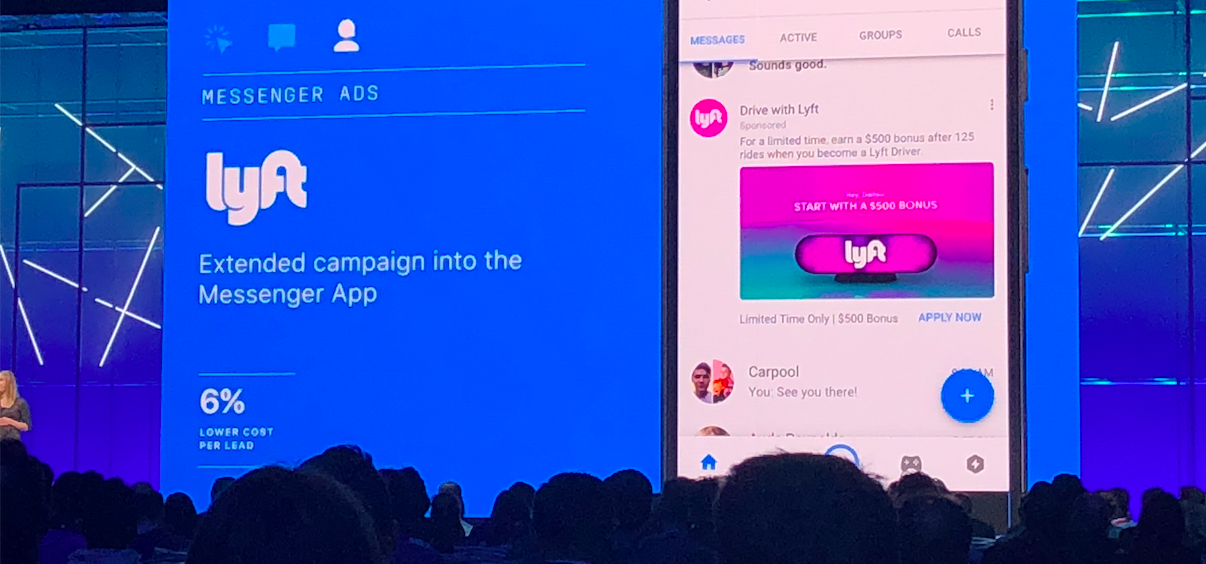Facebook Messenger is Truly Open for Business: Recapping the F8 Conference

While you were wondering how Facebook was going to make anyone get along (much less *date*) Messenger revealed itself as a marketing and business force.
Facebook may be taking on dating, but when it comes to business, brand and growth, the platform’s Messenger channel is already a match.Yes, our team of experts in marketing conversations made that pun, and we couldn’t be prouder. It’s all in the spirit of our visit to F8, the world’s most humor-filled developer conference. Just kidding (again) but it *was* filled with data, and we’re going to share all we can.Here are all the the deets on how Facebook Messenger is moving forward, straight from the center of it all. In short, it’s looking really good for brands.
Consumers are engaging on Messenger
Facebook has famously prioritized messaging (hello, WhatsApp) but the statistics shared at F8 this year signal an increase on Messenger as a marketing platform.There are now over 8 Billion messages being sent between businesses and consumers monthly on Messenger — quadrupled (yes, quadrupled) from last year’s 2 Billion — and they’ve had campaigns with 170% increase in conversion over websites.Right now there are around 300k monthly active “bots” on the platform. In this article (and in general), we’re defining bots as one-off, developer-built automated messaging experiences. They typically rely on AI despite its inadequacies, and are presented in the first-person, as human-like. While the use of bots is growing, it’s important to note that this growth will inevitably reach a scale ceiling (but more on that later).
The fact is, Messenger as a brand channel is growing, and fast.
There are many reasons for that, but one that’s very compelling is the numbers on consumer engagement.
According to stats shared in F8 keynote on Messenger for business, brands using Messenger have seen as high as 90% open rates. For perspective, the average open rate for email is around 32%, according to North American email and click-through rate trends for 2017.
Messenger is outperforming your traditional channels
Traditionally brands publish ads that point consumers to a website, where the end conversion really depends on the UX of the site’s ability to influence purchase, or conversion. Now brands can publish ads that opt consumers in to Messenger, where they’re invited into an automated conversation. Instead of clicking around a website, they’re participating in an exchange of useful information that leads them to the specific outcome they clicked through for.
The power of conversation to convert was obvious in some of the statistics shared at the F8 keynote.
For example, the Australian Open saw a 24x ROI increase compared to ads leading to their website and T-Mobile saw a 12% improvement in Messenger over web. While these statistics are specific to the brands and their campaigns, the increase in performance is significant.
Not only did consumer engagement and ROI see positive outcomes, but leads and ads were cheaper. Lyft saw a 6% lower cost per lead with ads run directly in the Messenger inbox, and T-Mobile cut their ad spend down by ¾ through optimized ads pointed at Messenger.
These stats aren’t the average performance rates — Messenger has only grown as a business growth channel really in this last year — but we’re looking at them as beacons of opportunity in taking advantage of Facebook Messenger as a business growth platform.
What makes Messenger work
With messaging channels you can acquire, qualify and convert a lead instantaneously. That sounds great enough, but beyond that — now that you know your customer so well — you can retarget them in the very same channel.
Throughout F8 were common themes around the need to ensure that the conversation experiences made to accomplish all of that be stellar and seamless. For many of the brands featured, that meant partnering with an agency that was up to the task of diving in, testing and iterating on the conversations. We’ve seen with the brands we work with how important it is to have visibility into what’s going on with your conversations, and be able to adjust them on an as-needed basis.
Taking advantage of other opt-in touchpoints like the Messenger website plugin is another way to optimize the experience — when a customer begins a conversation on your website you can learn about them, provide the most relevant resources and products, and re-engage them at a later point. This is a wild improvement to how most brands communicate with customers today.
Getting there
Marketers have long lauded the “Little Mermaid” growth principle (i.e. “I wanna be where the people are”) and Facebook marketing is no different. Considering the focus towards messaging at F8 it’s clear — the people are on Facebook Messenger. You wanna be there. And you should be able to not only access them, but tap into that sweet performance boost.
But many brands have (understandably, and strategically) opted out of messaging marketing because access is costly — it required hiring devs for long-term projects with unknown ROI. Not a lot of folks have been inclined to throw those resources around. And for those that have, they’re essentially getting a single campaign — they face a scale issue due to prohibitive workflows for content, pared with limited visibility. Reminds us of how you used to have to hire a developer for every html email campaign (a dark and expensive time).
Paloma, as a team and a platform, solves both the access and scaling issue by providing our messaging expertise with all the tools to truly manage campaigns and audiences on Facebook Messenger.
Feels like a no-brainer.
We’ve seen that access to experts in conversation experiences combined with the ability to create automated conversations can get brands off the ground.
But to really tap into the opportunity you’ll need all the tools you need to manage any other channel: content & audience management, a/b testing, tracking and performance, community management.
We’re sharing these exciting stats and platform updates not just because they’re exciting to us (and they are, Paloma is *ready* for the influx of creativity and personalization entering the space of marketing on Messenger).
Marketing teams deserve to know about the best new opportunities for growth, and have a way to tap into them. This is just the start.
Excited? Get in touch 💌

